Random Memories, Sangley Pt Deployment -1968/69

Contributed by CAPT Randy Hotten, USN (ret)
As soon as we landed at Sangley Point, we were loaded into a cattle car trailer, a standard Navy way of moving people around the base. We were taken straight to the base gym at Sangley Point for our VD lecture. An overweight Corpsman started talking about the diseases you could catch in town if you decided to sleep with the bar girls in town. He had slides of women’s crotches with ugly sores and guys private parts with puss dripping out. He told a story about a new STD called the “Black Clap”. It was disease for which there was no cure. If you were diagnosed with the “Black Clap” you moved to a ship anchored off the south coast of Vietnam. You were listed as MIA and your family was informed of your loss. I know that was pretty much BS, but he got his message across.
Our CO, CDR Bill Sanders, was out to set records for hours flown with the least number of aborts. We had two aborts in the month December. One of them was Paul Dykeman; he aborted for a mechanical generator failure. In NATOPS, this was a mandatory engine shutdown and return to base. That is what Paul did. The CO said loss of an engine in combat flying is not abort credit in his book, we fly on three engines all the time. He put Paul Dykeman in “Hack” as a message to everyone on how he felt about aborts on Market Time missions. Paul was confined to his room for the duration of this rotation in Utapao. The joke became among the JO’s was that the only acceptable abort criteria under CDR Sanders was an uncontrolled wing fire inboard of the outboard engine. We only had two more aborts in the next five and half months, and Sanders was recognized for setting the record for the least number of aborts.
We would be flying another night patrol on December 28th and I needed to get some rest. That was the day for the Bob Hope Show. We did not have to brief for our flight until 1900 and the show started at 1700. So, we got to go to the Bob Hope Show. He told a few jokes, but the high light of the show was Ann Margret. I recall perfectly that she was wearing a skintight body stocking that left little to the imagination. Plus he was wearing a VP-45 Ball Cap during his show.
On Jan 13th, we were going to move a detachment of two P-3’s from Wing 20 to Guam to do an ASW screening mission for the USS Enterprise while it was Enroute to Yankee Station. On the 14th we flew a 11-hour ASW barrier patrol in the area the Enterprise would be transiting. About four hours into our mission, we get a call that the USS Enterprise had caught on fire and would be returning to Pearl Harbor for repairs. The fire started when a Zuni Rocket detonated under a plane's wing. It spread as more munitions exploded, blowing holes in the flight deck that allowed burning jet fuel to enter the ship. 28 sailors were killed, 314 were injured, 15 aircraft were destroyed., Six years later I would get orders to be part of the ship’s company on the USS Enterprise. One of my duties would be inspection tours of the ship and on these inspections, I would visit the damaged area.
Sometimes we flew with an augmented crew - extra pilots and flight engineers, but fatigue was still an issue. You were busy on the south east coast of Vietnam flying in the shipping lanes, lots of things going on. However, when you turned northwest up the west coast of Vietnam there almost no contacts and the airplane would become quiet. There was no chatter, no tasks, it is pitch black, the drone of the engines filled the cockpit. The micro napping would start to set in. You would fight the sleepiness, but then you would finally nod off. One night around 0200-0300 we are at 1,500’ on three engines, with the auto pilot on. The airplane is quiet, with only the hum of the engines; I started fighting off sleep with micro napping starting to set in. Minutes are like hours fighting off the sleep, and then I completely nodded off. I awakened with a startle, not knowing if I had been asleep 30 seconds or 30 minutes. From the right seat, I look across the cockpit, and Bob Hartl in the left seat is asleep, and the flight engineer is also sleeping. I look back down the tube, everyone back there is asleep. I am the only person awake on the airplane. Holy CRAP! Thinking of a way to wake them without really waking them, I decide to call the galley for cockpit coffee, when Bob and the Flight Engineer hear my call on the PA, they also wake up and ask for coffee. Got my coffee, lite up one my Chesterfields and sat back to enjoy the rest of the night. At that time, I was smoking three packs a day of these short Chesterfield. Yea it might be considered unhealthy, as opposed to flying in Vietnam. An incident like that will really wake you up for a while, fatigue in these day/night flights was always an issue.
We were assigned the Ready One on April 13th Due to a pilot shortage, we had only two pilots assigned to the ready crew, Bob Hartl, and me. We had two NFOs in the back Bill Daily and Tom Lesko, we stood the ready with a short crew because you know they never launch the Ready One, well except when they do...like this time. We get alerted in the afternoon to cover Yankee Station that night. We would come out of Sangley at round 132,000 MGTOW on an airframe with a published MGTOW of 127,500. Wing stores you know, paraflares on four stations, full fuel and a “C” ASW load just in case we found a sub on Yankee Station. With water injection on a 95-degree day, we would need every inch of that 8000' runway. We start the takeoff roll, everything looks good. At 95kts water injection fails, B pump goes out. We drop down to low SHP and are 6,000' feet down this runway at around 100 Kts with rotate speed in 130 range. There is not enough runway to abort. As the end of the runway approached, we rotate well before we get to the 130 Kt speed. We stagger into the air and it will not climb, we are headed straight into Manila Int'l, slowly accelerating at about 50’ in ground effect, we finally turn and get the flaps up. In those P-3A days, water injection takeoffs could be exciting.
Toward the end of this deployment, the flights had become so routine it was difficult to distinguish one from another. One flight that comes to mind is we discovered after takeoff we had no radar. This was mission essential equipment. However due to CDR Sanders abort criteria of a wing fire as the only abort criteria, we continued our flight. Bill Daily had a copy of Lloyds of London sailing orders. We picked out the ships leaving Bangkok and figured out dead reckoning locations of the ships then to our route and made radar run ins on nine targets. The logs looked good and we were sure no bad guys snuck in during our flights. We flew back to Sangley on the 29th. I had flown 15 days the month of April and went over 100 hours again.
On a flight just after going on station south of the DMZ we picked up a target, a good-sized return and we commenced a radar run on the target. The target had no lights and we could not identity it. Thinking it might be a Navy ship we called on 277.8 UHF Fleet Common but no response. We decided we would have to illuminate the target. We set up our paraflare run and dropped the flare. As we started our turn back toward the ship, the ship came up on Guard 243.00 UHF , “We is the USS DuPont, we are friendly do not shoot, do not shoot” We looked at the ship with flare in the background; it was a US Destroyer Escort part of the Market Time force.
Send questions, comments or suggestions regarding this website to: vp45assoc@vp45association.org
Copyright © 2020 PATRON FOUR FIVE ASSOCIATION


